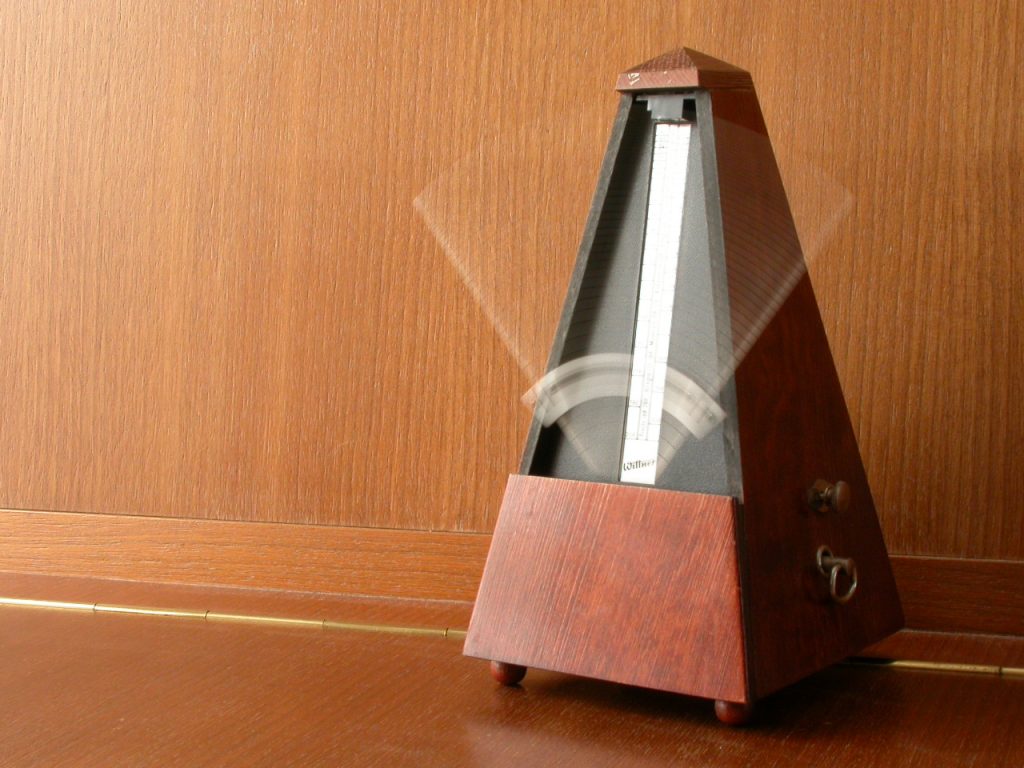How to Use a Metronome to Learn a 2/4 March

When you are learning a new competition march, do you often have trouble staying “on the beat” because you are using all of your concentration just to play all of the melody notes, gracenotes and embellishments correctly? Then, after you get those pesky things out of the way, are you still having trouble getting that “march feel”? Using a metronome during your practice may well be a useful tool for you.
As we mentioned in a previous post ("How to Use a Metronome to Improve Your Piping"), the metronome is a highly accurate and useful tool that, when used appropriately, can vastly improve our rhythmic accuracy and musicality. Yes, it is also an unrelenting truth detector. This article continues along the path of how to approach using a metronome to improve our playing, but this time with a competition march, "Allan Dodd’s Farewell to Scotland."
Competition marches have a 2/4 time signature, which indicates that there are two beats in a bar and the quarter note (equivalent) gets the beat. See Figure 1.

In this tune, each beat is comprised of groups of eighth notes, sixteenth notes, and thirty-second notes. The latter are the “cut” notes, which must be played as quickly as possible, but yet remain audible as a melody note. Thus, this tune exemplifies the “cut-dot” patterns that are found throughout competition marches. While all those notes and embellishments may seem daunting at first, if you have a plan, stick to the plan, and use a metronome as a learning tool, you might be surprised at how well you do with not only this tune, but other 2/4 marches.
First, it is best to learn a new tune bar by bar, getting the first bar down perfectly before moving to the next bar. Remember, playing an entire bar means that you start with the first downbeat of the first bar, play the second downbeat, and end on the first downbeat of the next bar. In this case, we will play both pickup notes at the beginning of the first bar, and end on the first E of the second bar (the dotted sixteenth note).
We know that we should play no faster than we are capable of playing all the notes and embellishments correctly, despite our impatient intuition to play faster! Slow is good. We can speed things up later. This is where good use of a metronome comes in. See Figure 2.

In Figure 2, both downbeats and upbeats (or offbeats) are marked with an arrow. Each arrow represents a click on the metronome. The entire first line of the tune is shown for context, but again, it’s best to focus only on the first bar. When both the downbeat and upbeat get a click, we are playing in “double time”. To start off, especially for a novice piper, the metronome should perhaps be set at a tempo of 60 beats per minute (bpm). This tempo in double time translates into a single time tempo of 30 bpm. But if a double time tempo of 60 still precludes getting in all the notes and embellishments, then slow it down farther. Playing in double time with a metronome to learn a new march helps the chances that the beats will fall accurately on the click. Most pipers play ahead of the beat, so listen carefully for gracenote placement. As a reminder, the G gracenote of the E doubling in the pickup notes gets a click, since we’re playing in double time. Then, the G gracenote to Low A gets a click, which is the first downbeat of the first bar. The second arrow in the first group of notes is aligned with the Low G of the taorluath, the note that gets a click representing the offbeat. Next comes another G gracenote of the C doubling, with the G gracenote needing to align with a click. Then an E gracenote to Low A gets a click, and we finish the first bar by playing a G gracenote to C, then the dotted sixteenth note E of the second bar. It would likely be a mistake at this point, for some pipers to attempt to play the entire first line. This is the best chance we have to get things right, the first time we start learning a tune. Learn it slowly and correctly early, and things will go well; learn it incorrectly at first, and you’ll waste valuable time trying to clean things up later, especially for adult learners.
The goal, of course, is to transition the metronome to sound a click only for the downbeats of a march. As a general rule, when you can play the bars, phrases, lines, and all the parts of a tune in double time at a tempo of say, 100 bpm, it’s a good time to go to single time with a tempo of about 50 bpm.
See Figure 3.

Figure 3 represents single time rhythm, with the arrows designating where the downbeats should align perfectly with the clicks of the metronome. Keep things slow at first, and get everything in and precisely on the beat. Increase the single time tempo no more than 2-3 bpm each time, and assure that everything is being played correctly. After all of the fundamentals are keenly in place (basic rhythm, scale navigation, articulation [gracenotes and embellishments] and small scale dynamics [ALAP/ASAP]), then and only then can the large scale pulsing dynamic come into play.



Responses